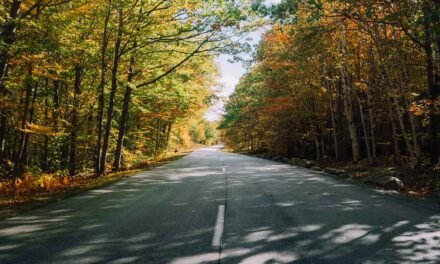Acadia National Park is an amazing destination for outdoor activities. Whether you’re looking for a leisurely drive or an adventurous hike, things to do in Acadia National Park include hiking, scenic drives, wildlife watching, kayaking or canoeing, biking, rock climbing, fishing, camping, ranger-led programs, and beachcombing. Be sure to bring the necessary equipment and clothing for the activity you choose and plan ahead for changing weather conditions.
Table of Contents
#1 – Hiking in Acadia National Park
Acadia offers a variety of hiking options, ranging from easy nature walks to challenging mountain ascents. The most popular hike is to the top of Cadillac Mountain, which offers breathtaking views of the surrounding park and ocean. The weather can vary greatly in Acadia, so be prepared for sun, rain, and cooler temperatures, especially at higher elevations. During the summer months, bring plenty of water and sunscreen, while in the fall, bring layers to stay warm. Hiking equipment needed includes comfortable shoes, appropriate clothing, a hat, and a backpack with snacks, water, and a map.
#2 – Take on of the Scenic Drives in Acadia National Park
Take a leisurely drive along the 27-mile Park Loop Road to see some of the most breathtaking views in Acadia. This road takes you through forests, along the coastline, and up to the top of Cadillac Mountain. The weather can be variable, so be prepared for sun, clouds, and rain, especially during the spring and fall months. A good season to visit is during late spring, summer or early autumn. The drive is best done in a private vehicle, but shuttle buses and tour buses are available for those without access to a car.
#3 – Find Some of Acadia National Park’s Wildlife
Acadia is home to a variety of wildlife, including moose, black bears, and a variety of bird species. To increase your chances of seeing wildlife, take a drive along the Park Loop Road or go on a wildlife watching tour. The best time to see wildlife is early in the morning or late in the evening. Dress in layers and bring binoculars and a camera to get a closer look and take photos. Keep in mind that wildlife can be unpredictable and it’s important to keep a safe distance and not approach or feed them.
#4 – Try Kayaking or Canoeing in Acadia National Park
Paddle along the calm waters of Frenchman Bay and other lakes within the park for a peaceful and scenic experience. The best time to kayak is during the warm months, from May to October. Rent a kayak or canoe from a local outfitter, or bring your own if you have one. Life jackets, paddles, and a waterproof container for your belongings are typically provided by the rental company.
#5 – Rent a Bike and Explore
Rent a bike or bring your own and explore the park’s historic carriage roads, which were built by John D. Rockefeller Jr. in the early 20th century. These roads offer scenic views of the park and are a great way to get around without the hassle of traffic. If you’re looking for a more challenging experience, take a mountain bike along the park’s many trails. The best time to bike is during the warm months, from May to October. Rent a bike or bring your own and make sure to bring a helmet, water, and appropriate clothing.
#6 – Try Rock Climbing in Acadia National Park
The cliffs along the coast of Acadia offer a unique and challenging rock climbing experience. With routes ranging from easy to expert, there’s something for every level of climber. The best time to climb is during the warm months, from May to October. If you’re new to climbing, consider taking a guided tour for a safe and enjoyable experience. Climbing equipment can be rented from local outfitters, or bring your own if you have it. This equipment typically includes a helmet, harness, shoes, and carabiners.
#7 – Slow it Down With Fishing in Acadia National Park
Cast a line in the streams, ponds, and along the shore for a chance to catch brook trout, smallmouth bass, and other species. The best time to fish is during the warm months, from May to October. A fishing license is required and can be purchased at local outfitters or online. Bring your own fishing gear or rent it from a local outfitter.
#8 – Get Back to Nature With Camping in Acadia National Park
Acadia offers several campgrounds, both within the park and nearby, for those looking to spend the night under the stars. Whether you’re looking for a backcountry experience or the comfort of a RV, there’s something for everyone. The best time to camp is during the warm months, from May to October. Be prepared for changing weather conditions and bring a tent, sleeping bag, camping stove, and other necessary camping gear. Reserve your campsite in advance, as they can fill up quickly during peak season.
#9 – Learn from an Acadia National Park Ranger
Join a ranger-led program for a fun and educational experience in Acadia. These programs range from guided hikes and wildlife watching tours, to night sky viewing and campfire programs. Programs are offered during the summer months and are subject to change based on weather and staffing. Check with the park’s visitor center for the most up-to-date schedule of ranger-led programs.
#10 – Discover More by Beachcombing in Acadia National Park
Explore the rocky shores and sandy beaches of Acadia for a chance to find seashells, sea glass, and other natural treasures. The best time to beachcomb is during low tide, when more of the shore is exposed. The best beaches for beachcombing are Sand Beach and Otter Cove. Be sure to leave any living creatures, such as starfish and mussels, in their natural habitat. Dress in layers and bring a hat, sunglasses, and sunscreen to protect yourself from the sun
Don’t miss a trick on your next visit to Acadia. Check out our Acadia National Park Guide!




